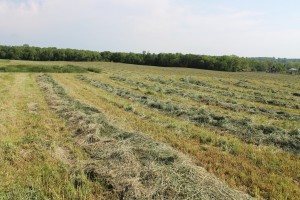PIKETON, Ohio — Cattle producers who want to ensure a healthy, productive calving season might want to consider testing the nutritional values of forage supplies, an Ohio State University Extension beef expert says.
Feeding poor-quality forages to cows in the late-gestation or early lactation period can reduce body condition scores and, ultimately, conception rates in the following breeding season, said John Grimes, beef coordinator for OSU Extension.
If producers find they have poor-quality forages, they might want to supplement the feed with higher-quality corn for those cows -particularly with first-calf heifers, he said.
“In nearly every cow-calf operation, harvested forages are the primary diet component of winter rations, but we typically know less about those forages than any other feed and health products consumed by the herd,” Grimes said.
“It’s easy to over-value hay that looks good in the bale while we may have forgotten how mature it was when it was packaged.”
Drought effect
The issue is even more significant this year, considering that the drought of 2012 was one of the worst on record in the eastern Corn Belt, leaving many livestock producers hard-hit in their pastures and forages.
“The drought caused shorter supplies, so there may be some less-desirable hay,” Grimes said. “So if your hay isn’t good enough — you test it and it is nutritionally inferior — you may have to supplement with byproduct feed or corn. Poor-quality hay cannot be improved by feeding more poor-quality hay.”
Instead, producers might need to balance rations with corn or grain byproducts to meet the needs of mature or growing females under production stress.
“For a cow to calve every year, which producers need in order to pay the bills, the cow needs to rebreed within 90 days of calving, so you need to ensure that females receive feeds that are high in quality and adequate in volume. Producers need to consider when their calving season is, how that relates to the feed they have and how they will distribute that feed.”
Body condition
To ensure a more successful, healthy and productive calving, cows need to maintain adequate body condition scores during critical production times.
“If you feed lower-quality feed to cows in the late-gestation or early lactation period, they will regress and lose body condition,” Grimes said.
Body Condition Scores (BCS) ranging from fix to six are considered ideal during late gestation or early lactation in this scoring system where one is thin and nine is obese.
“Poor nutrition and declining BCS during late gestation or early lactation can have devastating impacts on conception rates in the following breeding season, he said.
Within 30 to 60 days of breeding, producers should consider putting the cow on an inclining or improving nutritional program, Grimes said. While that can be expensive, not improving the nutritional value will be much more costly in the long run.
“It may be painful to buy expensive supplemental feed, but be more expensive to have an open cow, which won’t be able to breed,” he said. “If the cow is thin or in poor state of nutrition, she won’t breed or it will take multiple services to conceive.
“It’s kind of like the old saying, ‘you pay me now or you pay me later.’ It’s better to supplement substandard hay with expensive corn rather than have poor reproductive performance after calving.”












